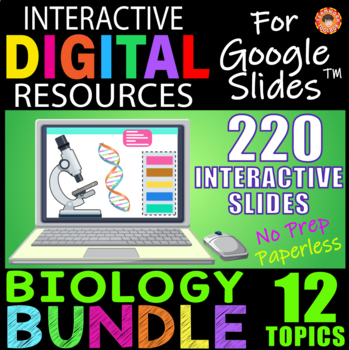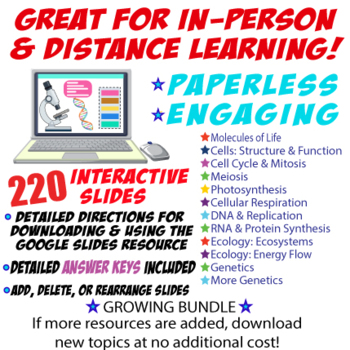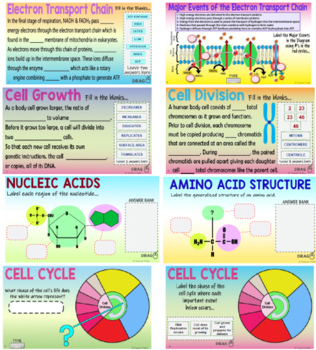12 Topic BIOLOGY BUNDLE ~Interactive Digital Resources for Google Slides~

What educators are saying
Products in this Bundle (12)
showing 1-5 of 12 products
Description
✅12 Resources for Google Slides: This bundle contains 12 interactive digital resources for Google Slides™ that will help your biology students learn and master critical and challenging biology concepts throughout the course. Students will drag movable objects, select fill in the blank answers, and type to enter information as they learn and review comprehensive concepts for each topic. Many Slides feature helpful charts, diagrams, and images to reinforce learning. Use each resource in a variety of ways- assigned as classwork/homework/groupwork, use during tutoring sessions, give your own notes while students complete Slides, and more.
✨✨✨Works great for Distance, In-person, or Hybrid Learning!✨✨✨
⚡Will these work in my School's Learning Management System?
If you are able to use Google Slides in your current LMS, you can use this bundle with your students as well. Your students will have to have Gmail Accounts (GSuite for Education is free for schools). You can download this freebie to do a test run if you'd like.
I used these last year in Canvas. Although you don't have to assign them this way in Canvas, the Google Assignments External Tool 1.3 in Canvas does a great job of connecting Google Slides/Docs:
https://support.google.com/edu/assignments/answer/9381694?hl=en
★ NO PREP ★ PAPERLESS ★
Assign each paperless 30-50 minute activity quickly & easily as in-class guided practice, small group classwork, or as homework. Works great for Google any device that supports Google Slides.
Each resource includes a detailed Teacher Answer Key.
Within each resource, slides can be added, deleted, or rearranged. The backgrounds are fixed images.
★INCLUDED IN THIS BUNDLE★
✅Detailed Directions for Downloading and Assigning each Resource
✅12 Resources for Google Slides:
⭐Molecules of Life (100 problems)
⭐Cells: Structure & Function (50 Problems)
⭐Cell Cycle & Mitosis (60 problems)
⭐Meiosis (60 problems)
⭐Ecology: Ecosystems (75 problems)
⭐Ecology: Energy Flow (75 problems)
⭐Genetics (50 problems)
⭐More Genetics (40 Problems)
⭐DNA & Replication (60 Problems)
⭐RNA & Protein Synthesis (60 problems)
⭐Photosynthesis (60 problems)
⭐Cellular Respiration (80 problems)
✅Detailed Teacher Answer Key for Each Resource
✅Teacher Answer Key Summary PDF's for Each Resource (6 Slides per Page)
Technology Required!
***Students must have internet devices capable of using Google Slides™. This resource will work on any device that can access and use Google Slides. Google Classroom™ allows you to easily assign students their own copy with just a few mouse clicks (instructions included). This resource is no prep if you already have Google Drive or Google Classroom™ set up.
⭐These also work in any LMS that can assign Google Slides/Docs such as Canvas or Schoology.
★Benefits of using Google Apps★
•No copies to run
•Student work saves automatically
•Teachers can easily monitor progress and learning
•Students prefer using technology. It's engaging and familiar.
•Work can be easily assigned or finished as homework
★Check out my ANATOMY Digital Resources for your Google Slides★
Intro to Anatomy Digital Resource
Tissues & The Integumentary System
Peripheral Nervous System (Cranial & Spinal Nerves, Reflexes)
⭐Check Out my CHEMISTRY Digital Resources for Google Slides⭐
Mole Conversions Digital Resource
Stoichiometry Digital Resource
Acids Bases pH Digital Resource
Measurement & Conversions Digital Resource
Electron Configurations Digital Resource
The Periodic Table Digital Resource
Nuclear Chemistry Digital Resource
Oxidation-Reduction Digital Resource
Specific Heat & Heat Transfer Resource
Gas Laws & Gas Properties Resource





